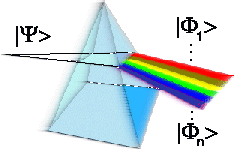M.A. Załuska-Kotur, M. Gajda and J. Mostowski
We study a system of trapped bosonic particles interacting by model harmonic forces. Our model allows for a detailed examination of the notion of an order parameter (a condensate wave function). By decomposing a single particle density matrix into coherent eigenmodes we study an effect of interaction on the condensate. We show that sufficiently strong interactions cause that the condensate disappears even if the whole system is in its lowest energy state. In the second part of our paper we discuss the validity of the Bogoliubov approximation by comparing its predictions with results inferred from the exactly soluble model. In particular we examine an energy spectrum, occupation, and fluctuations of the condensate. We conclude that Bogoliubov approach gives a quite accurate description of the system in the limit of weak interactions.
Acta Phys. Polon. A 100, 485 (2001)
Jul 26, 2001
Motion of vortex lines in nonlinear wave mechanics
Iwo Białynicki-Birula and Zofia Białynicka-Birula
We extend our previous analysis of the motion of vortex lines [I. Bialynicki-Birula, Z. Bialynicka-Birula, and C. Śliwa, Phys. Rev. A 61, 032110 (2000)] from linear to a nonlinear Schrödinger equation with harmonic forces. We also argue that under certain conditions, the influence of the contact nonlinearity on the motion of vortex lines is negligible. The present analysis adds new weight to our previous conjecture that the topological features of vortex dynamics are to a large extent universal.
Phys. Rev. A 65, 014101 (2002)
We extend our previous analysis of the motion of vortex lines [I. Bialynicki-Birula, Z. Bialynicka-Birula, and C. Śliwa, Phys. Rev. A 61, 032110 (2000)] from linear to a nonlinear Schrödinger equation with harmonic forces. We also argue that under certain conditions, the influence of the contact nonlinearity on the motion of vortex lines is negligible. The present analysis adds new weight to our previous conjecture that the topological features of vortex dynamics are to a large extent universal.
Phys. Rev. A 65, 014101 (2002)
Jul 3, 2001
Spontaneous Emission by Atoms in Simple Environments
Władysław Żakowicz
Spontaneous radiation by atoms in the presence of the planar dielectric--vacuum interface, planar dielectric waveguides and cylindrical dielectric waveguides are discussed in the frame of cavity quantum electrodynamics in full analogy with that in free space. However, quantization of the electromagnetic field should be based on the modes appropriate to the selected space structure. These quantizations are usually based on incoming waves. However, the discussion of the angular intensity pattern of spontaneous emission can be simplified if the quantization is based on outgoing modes. Using these outgoing photons the angular emission radiation pattern has been obtained from a straightforward application of the perturbative method of the quantum radiation theory. Adding a contribution of the waveguiding photons attached to the waveguides (when they are present) the total emission of the spontaneous radiation and excitation decay rates of atoms radiating in these systems have been derived.
Acta Phys. Polon. A 101, 119 (2002)
Spontaneous radiation by atoms in the presence of the planar dielectric--vacuum interface, planar dielectric waveguides and cylindrical dielectric waveguides are discussed in the frame of cavity quantum electrodynamics in full analogy with that in free space. However, quantization of the electromagnetic field should be based on the modes appropriate to the selected space structure. These quantizations are usually based on incoming waves. However, the discussion of the angular intensity pattern of spontaneous emission can be simplified if the quantization is based on outgoing modes. Using these outgoing photons the angular emission radiation pattern has been obtained from a straightforward application of the perturbative method of the quantum radiation theory. Adding a contribution of the waveguiding photons attached to the waveguides (when they are present) the total emission of the spontaneous radiation and excitation decay rates of atoms radiating in these systems have been derived.
Acta Phys. Polon. A 101, 119 (2002)
Subscribe to:
Comments (Atom)
